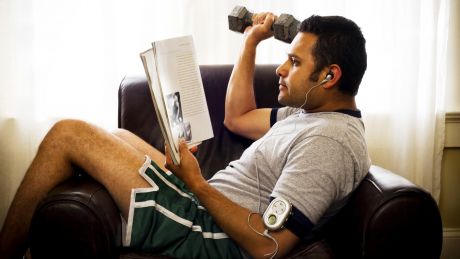Can You Really Shed Fat Without Going to the Gym?
Nutritionist Drew Price tests the slow-carb diet's claim to help you fight flab without leaving the kitchen

The diet
The Slow Carb Diet involves taking bites of bread and chewing each mouthful 200 times before swallowing. Just kidding – it’s a diet developed by author and lifestyle guru Tim Ferriss, originally featured in his book The 4-Hour Body, and based around five simple eating rules that combine what he thinks are the most effective evidence-based fat-loss principles.
The claim
The most up-to-date version of the diet, which you can find on Ferriss’s blog, makes the bold claim that it will enable you to lose 9kg of fat in 30 days – without doing any exercise. With exercise the results are supposedly even better.
The method
Slow Carb is based on five simple rules, with the aim of maximum simplicity:
- Don’t eat white carbohydrates.
- Eat the same few meals over and over.
- Don’t drink your calories.
- Don’t eat fruit.
- One day a week, anything goes.
Within the second rule there’s a list of specific meats, vegetables and legumes you can use to construct your meals. Provided you stick to these you can eat as much as you want, so there’s no need to track your intake of calories or macronutrients.
Ferriss also encourages the use of the Coach.me app, which helps you stay in touch with other ‘slow carbers’ to build a social support network to motivate and encourage each other stick to the diet.
The reality
The diet is simplicity itself, and although the explanation in Ferriss’s book is short, there’s plenty of additional info on his blog to give you clear instructions. Repeating the same few meals made things very easy and because they were mostly made from high-protein and high-fibre foods, I was never hungry. In fact, eating mountainous burrito bowls topped with guacamole meant I didn’t really feel I was on a diet.
Another little bonus was the daily allowance of red wine, which Ferriss thinks speeds up recovery from training and fat loss. This also made the social impact of the diet a lot smaller. The free day – where you’re actively encouraged to go crazy and eat whatever you like – also made eating socially a lot easier, but the day after was pretty tough (although the support of the Coach.me app definitely helped with this).
Get the Coach Newsletter
Sign up for workout ideas, training advice, reviews of the latest gear and more.
The results
I was sceptical about the diet’s claims, but after sticking to it strictly for a while my gym sessions were going well, so I was confident that I’d achieve decent results. Unfortunately this wasn’t the case. When I tested my body composition with Speedflex, the results were eye-opening – I found I’d actually lost 1kg of muscle and gained 1kg of fat! I tested and retested, not wanting to believe the results, but the numbers remained the same.
The situation wasn’t much better on the inside either. Although my glucose and triglyceride levels improved, my ‘bad’ LDL cholesterol had increased by almost 25%. Looking back over my food diaries, I’d followed Ferriss’s five rules to the letter, so what went wrong? If I had to guess, I’d assume the problems might have stemmed from my enthusiastic interpretation of ‘eat as much as you like’.
The verdict
There are plenty of ‘success stories’ on the net involving Slow Carb, but the theme seems to be that it works best for people who have a lot of weight to lose, and it didn’t deliver on its promises for me. It’s simple and easy to follow, but if you’re already in decent shape, my advice is to try something else.
Good to slow
Here’s what Price consumed on a typical slow carb day
Breakfast: 4 eggs rancheros with black beans and guacamole
Mid-morning: Coffee
Lunch: Chicken salad with hummus
Mid-afternoon: Coffee
Post-training snack: Chicken with hummus and red pepper sticks
Dinner: Roasted beef slices with Mexican spices, salsa, guacamole and refried beans
Coach is a health and fitness title. This byline is used for posting sponsored content, book extracts and the like. It is also used as a placeholder for articles published a long time ago when the original author is unclear. You can find out more about this publication and find the contact details of the editorial team on the About Us page.

